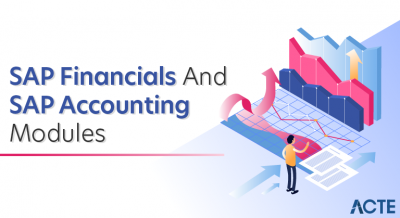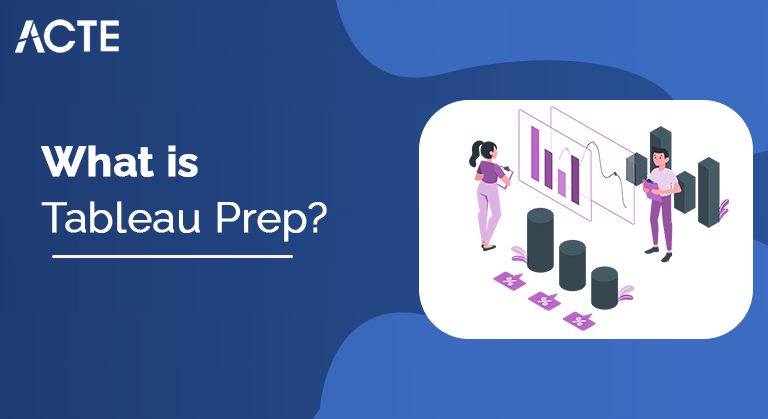
Tableau Prep is a data preparation tool which aims to automate the cleaning process to help you shape your data in a visual manner. Tableau Prep is a self-service tool that makes it easier for any analyst to create simple flows and reuse it. This blog explains the features of Tableau Prep with a simple flow.
- Introduction to Tableau Prep
- Using Tableau Prep
- Features of Tableau Prep
- A tour of the Tableau Prep workspace
- Connections pane
- Flow pane
- Profile pane
- How Tableau Prep stores your data
- Benefits of Tableau Prep
- Conclusion
Introduction to Tableau Prep:
Tableau Prep Builder is a tool in the Tableau product suite designed to make preparing your data easier and easier. Use the Tableau Prep Builder to compile, organise, and clean up your data for analysis in Tableau.
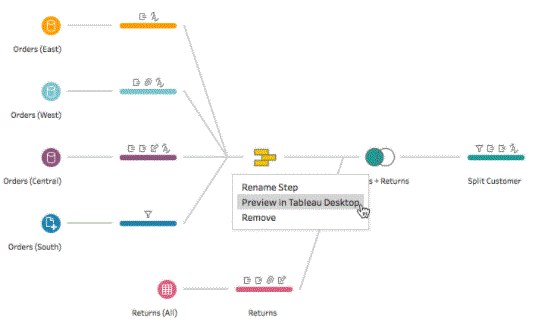
Using Tableau Prep:
Start by connecting to your information from varied files, servers, or Tableau extracts. Connect and merge information from multiple information sources. Drag and drop or double-click to bring your tables to the flow window, then add flow steps wherever you’ll use common functions like filter, split, rename, pivot, join, union and additional to wash and form your information.
Each step within the method is clearly displayed within the flow chart that you simply produce and manage. Tableau Preparation tracks every performance thus you’ll check your work and create changes at any time on the go.
When you are through with your flow, run it to use practicality across the complete information set. Tableau Preparation works seamlessly with different Tableau merchandise. At any time in your travels, you’ll produce a chunk of your own information, publish your information supply to Tableau Server or Tableau on-line, publish your stream to Tableau Server or Tableau on-line to continue written material on the net or change your information employing a schedule. you’ll conjointly open Tableau Desktop directly within Tableau Preparation Builder to preview your information.
- Data roles
- Group and Recovery (also applies to fields with information roles beginning in version 2019.2.3)
- Sort
- Replace empty worth values
- Delete fields
- Divide (version 2019.1.1 and later)
- Group and Replace
- The team uses Fuzzy Match to gather numbers supported the subsequent
Features of Tableau Prep:
Connect and extract information
You will be ready to hook up with the subsequent information sources and extract the information. excluding this, you’ve got the choice to attach to different ODBC and JDBC communications exploitation the acceptable computer address and details. Apart from this, you’ll conjointly import pre-published information from Tableau Server to make streaming.
Clear Data
This is a key step in serving to you to wash up your information. Within the example, the clean step used for Filtering, works out values by empty values. Tableau Preparation conjointly has the choice to perform improvement tasks exploitation recommendations.
Types of recommendations include:
Pronunciation: exploitation of the “pronunciation group” of the Tableau Preparation, something which will sound similar is classified into one class. For instance, William and Williamems were to be placed along.
Common Characters: What concerning the texts “Bieber, Justin” vs “Justin Bieber”. Due to Prep’s “Group – Common Character” feature, we will mix this into one business. Also, this will be terribly tough to realise with formulas – even the foremost powerful Regular Expression formulas in Tableau won’t give a straightforward resolution to the present.
Spelling + writing system: (version 2019.1.4 and later) – you’ll assign your information role and use it to align and collect values, this may collect invalid values based on writing system and pronunciation. Tableau Preparation Builder mechanically adds and marks a worth as not within the actual information set. This selection is best fitted to English words.
Sorting: Tableau Preparation Builder offers a spread of choices that you simply will use to filter your information. For instance, use Save solely or don’t Forget to try and do one-click filtering on a field worth within the profile card, information grid or leads to the cardboard, or choose from a spread of filters to get complicated filter necessities. you’ll conjointly save or delete all fields.
Consolidation: There is also things wherever you may got to modify {the information|the info|the information} graininess – either reducing the quantity {of information|of knowledge|of information} generated from the flow or syncing data with different data you’ll wish to hitch or merge. contemplate a state of affairs wherever you’ve got a share of your information at the merchandise level and need to look at sales at the client level. you’ll mix information from product level to client level then mix it with another table with client info.
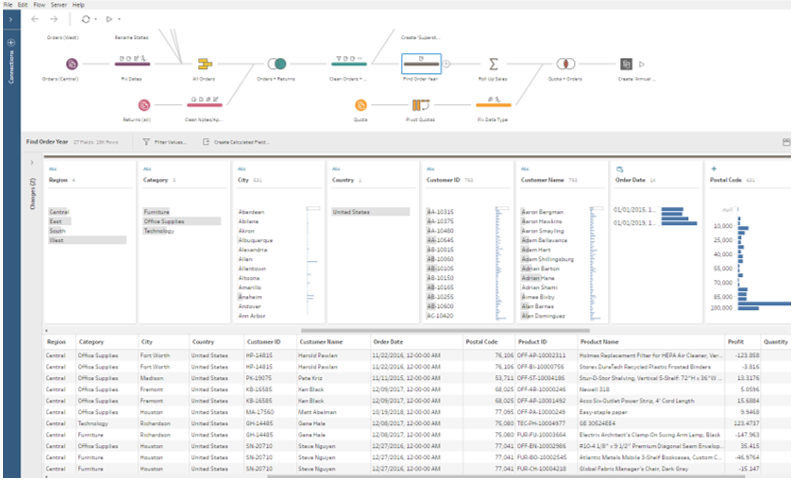
A tour of the Tableau Prep workspace:
The Tableau Prep workshop contains a Connections (A) window where you connect to your data sources, with three integrated areas that help you connect and view your data:
Flow Window (B): Visual representation of your performance steps as you process your data. This is where you can add steps to build your flow.
Profile window (C): A summary of each field in your data sample. See your data status and quickly find outliers and blank prices.
Data Grid (D): Details of the line level of your data.
After you connect to your data and start building your flow, you add steps to the flow window. These steps act as a lens to the structure of your data, as well as a summary of the functions used in your data. Each step represents a different category of tasks you describe, all as part of your journey.
Connections pane:
To the left of the workspace is a Connections window, which displays information and files you are connected to. Add a link to one or more data sources and drag the tables you want to work with to the flow window. For more information see Connect to Data (Link opens in new window).
You can minimise the Connections window if you need more space in your workspace
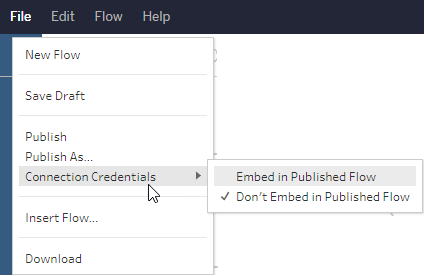
Flow pane:
At the very best of the area could also be a Flow window. typically|This can often be} often where you’ll build your flow. As you connect, clean, shape, and compile your data, the steps appear among the flow window and align from left to right at the very best. These steps tell you what quiet activity is being used, what program it’s, and therefore the method your data is suffering from. As an associate degree example, the be a {part of} step shows you what quite be part of you has got entered, be a part of categories, recommended be a part of categories, and table fields closed among the be a part of.
You start your flow by dragging tables among the flow window. Here you will be able to add further data sets, rotate your data, union or be a part of data, manufacture ratings, and generate output files with .tds files, Hyper extract (.hyper) files, or discovered data sources simply} just can use in Tableau. you will be able to even write your exit data on the net website. for added information on producing output files, see Save and Share Your Task (Link opens in new window).
- Search, sort, and type fields
- Sort, enter, or exclude values
- Find and fix empty values
- Rename fields
- Clear knowledge entry errors exploitation cluster values or cleanup tasks right away.
- Use auto-data analysis to change knowledge sorts.
- Rearrange the layout of your field columns by dragging them and putting them wherever you wish them to be.
- Select one or a lot of field values on the Profile card and so right-click or Ctrl-click (MacOS) to envision further choices for saving or subtracting values, elite cluster values or Null values.
- Tableau Preparation tracks any changes you create, within the manner you are doing, therefore you’ll continuously return and update or edit those changes if necessary. Use drag and drop to set up list functions to do and apply changes otherwise.
- Click the upper-right arrow of the window to expand and collapse the Changes window to induce a lot of work and knowledge within the profile window.
- For a lot of info on exploitation cleanup knowledge in your knowledge see Clean and form knowledge (Link opens in new window).
Profile pane:
In the centre of the space there’s a Profile window. The Profile window shows you the format of your knowledge at any time on the go. The structure of your knowledge may be described in numerous ways that reckon the performance you wish to perform on your knowledge or the action you decide on within the flow window. At the highest of the Profile window there’s a toolbar showing you the cleansing tasks you’ll perform in every step in your journey. the choices menu conjointly seems on every card within the Profile window wherever you’ll choose completely different tasks to perform on the info.
For example:
Data grid
At very cheap of the space could be a knowledge grid, that displays linear details for your knowledge. The values shown within the knowledge grid mirror the activities delineate within the Profile window. you’ll do identical cleansing tasks here as you’d within the profile window if you decide on to figure out a lot of elaborated levels.
- Custom SQL utilised in the Input steps
- Sorting (data entry)
- Group Values (in information entry)
- Statistics
How Tableau Prep stores your data:
When you connect Tableau Preparation to your information and build a stream, it saves oft used information within the .hyper file. for giant information sets, this might be a knowledge sample. Any hold on information is held below a secure directory of a short lived come in a file known as preparation BuilderXXXXX, wherever XXXXX represents the distinctive symbol worldwide (UUID). Once saving the flow, the file is deleted. For additional data on however Tableau Preparation samples your information, see Set your sample size (Link opens in new window).
Tableau Preparation Builder additionally saves information in an exceedingly Tableau flow file (.tfl) to support the subsequent tasks (which will take the number of information entered):
- Tableau Prep is used only for static data extraction.
- No editing on the original Prep version.
- If you want to update data, you need to re-use the flow from Prep.
- In the data connection window, SAP HANA, Tableau Server etc are not currently available.
Benefits of Tableau Prep:
BEAUTY:
1. Quickly assemble, shape, and clean their data for analysis.
2. At any time while working in Tableau Prep, you can create a portion of your data, publish your data source in Tableau Server or Tableau Online, or open Tableau Desktop directly in Tableau Prep to preview your data.
3. Allows you to keep track of your data, interact directly with prices to fix problems, and see the results of every change to make sure you get the right data.
4. Three-dimensional view allows you to view line-level data, profiles for each column, and your entire data setup process. Choose which idea you will work with based on the work you do.
5. Tableau Prep uses subtle combinations to convert repetitive tasks, such as word combining, into one-click tasks.
6. It is easy to open the output via Tableau Desktop or share it with others via Tableau Server or Tableau Online. Easy sharing minimises conflict and helps you close the gap between data adjustment and statistics, for better business results.
7. Tableau Prep is included next to the Tableau Desktop in the new Tableau Creator offering.
PAIN:
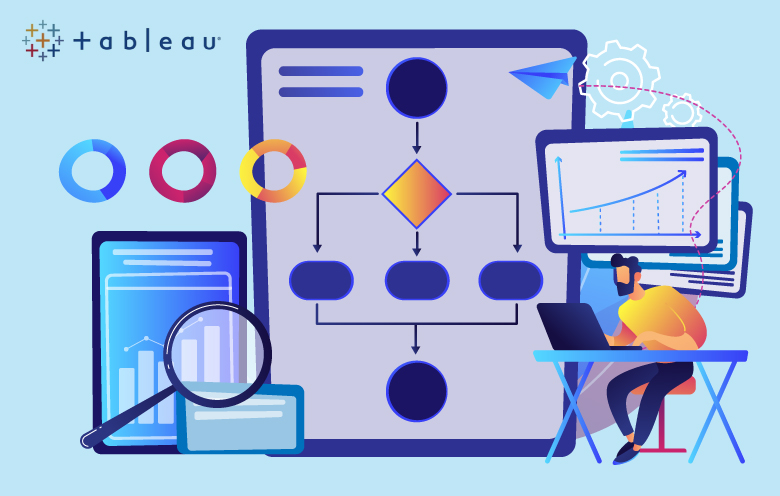
Conclusion:
Tableau Preparation Builder could be a tool within the Tableau product suite designed to make readying your knowledge easier and easier. Use the Tableau Preparation Builder to compile, organise, and pack up your knowledge for analysis in Tableau. a pair of had modified its name to Tableau Preparation Builder and remarked the Desktop application.
Tableau Preparation could be a latest product from Tableau designed to assist everybody quickly and with confidence to compile, shape, and pack up their knowledge for analysis. Direct, intuitive sensitivity offers you a deeper understanding of your knowledge and smarter sense makes knowledge preparation easier and additional accessible.
Uninstall Step, you’ll stop preparation Builder to extract knowledge like Tableau export or CSV file. In testing, we have a tendency to find that a similar, giant knowledge set took a pair of hours and forty seven minutes to extract as CSV, however solely eleven minutes to extract as Hyper extract.





